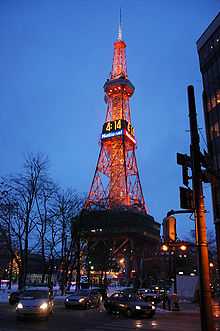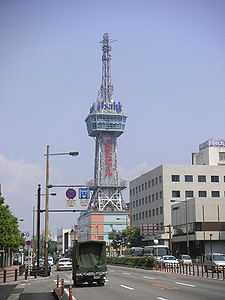Tachū Naitō
Tachū Naitō (内藤 多仲 Naitō Tachū, 12 June 1886 - 25 August 1970) was a Japanese architect, engineer, and professor from Yamanashi Prefecture, Minami-Alps, Yamanashi. He was a father of earthquake-proof design and built many broadcasting and observation towers, including the Tokyo Tower.
Biography
Tachū Naitō attended the Old System Kofu Middle School (presently Yamanashi Prefectural Kofu First High School), he passed high school, then attended the Tokyo Imperial University (presently the University of Tokyo). Natiō started out studying naval architecture, but then turned to architecture due to the shipbuilding depression after the Russo-Japanese War. He studied with Kino Toshikata and graduated in 1910. In 1913, he became a professor at Waseda University.
In 1916, he went to America as an international student where he devised his seismic theory of the earthquake-proof wall. While on the First Transcontinental Railroad, he made observations about the movements of the luggage depending on the trains acceleration after noticing the scattered trunks when the train made sudden stops. The lack of partitions in the luggage compartment and the disarray of the trunks led him to the structural idea of the earthquake-proof wall,[1] effectively a shear wall.
Using the seismic structural theory that he devised, he engineered the Industrial Bank of Japan's main office which was designed by Setsu Watanabe. Three months after the building's completion in 1923, the Great Kantō earthquake happened. This structure withstood the damage and Naitō included this fact in his lectures as the effectiveness of his earthquake-proof design theory had been proven.
Other than the Industrial Bank of Japan, he worked on the Kabuki-za and the Okuma auditorium. Naitō designed many broadcasting towers as well, the Nagoya TV Tower in 1954, the Tsutenkaku in 1956, the Sapporo TV Tower and Beppu Tower in 1957, and the Tokyo Tower in 1958.
Tachū Naitō held many positions and was recognized with many awards throughout his career. In 1938, he became the chairman of the Japan Welding Society. In 1941 he was named the chair of the Architectural Institute of Japan and in 1954 became a member of the Science Council of Japan. Naitō became a member of the Japan Academy in 1960 and he was awarded a distinction for cultural merit in 1962 and the second-class Order of the Rising Sun in 1964.
On August 25, 1970 at 9:05 AM, Tachū Naitō died in the National Tokyo First Hospital, now the International Medical Center of Japan, at 84 years of age. His remains were buried in the graveyard of the Naitō family in Tamareien Cemetery. His epitaph is on the right side, and a bronze statue is on the left.
Gallery
-
Nagoya TV Tower (1954)
-

Tsutenkaku(1956)
-

Sapporo TV Tower (1957)
-

Beppu Tower (1957)
Notes
References
- 『建築構造学』 Architecture Studies, 1918
- 『架構建築耐震構造論』、早稲田大学出版会. Seismic Structural Theory, Waseda University Publications, 1924
- 『日本の耐震建築とともに』、雪華社. Earthquake-proof Architecture of Japan, Yuki Hana Corporation, 1965
- 『建築と人生』、鹿島出版. Architecture and Life, Kahima Publications, 1966
- 『内藤多仲博士の業績』、鹿島出版会. The Achievements of Doctor Tachu Naito, Kashima Publications, 1967
- 『タワー 内藤多仲と三塔物語』、INAX出版. Birth of Towers: Tachu Naito and a Tale of Three Towers, INAX Publications, 2006
External links
| Wikimedia Commons has media related to Tachū Naitō. |
- (Japanese) 神戸新聞 正平調(2003年8月30日)
- (Japanese) 歴史が眠る多磨霊園 内藤多仲
- (Japanese) タワフル(TOWERFUL) コラム 塔博士
- (Japanese) Hiro Satoshi Noguchi, Tachu Naito Exhibition in Ginza, 16 October 2006
- Tokyo Art Beat review of Birth of Towers: Tachu Naito and a Tale of Three Towers
|
